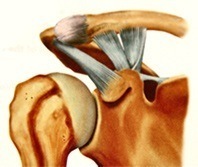Acromioclavicular (AC) joint separation is a common shoulder injury in many contact sports, affecting the mobility and the aesthetics of the shoulder joint. Dr. Steven Struhl is one of the top orthopedic surgeons in the country, specializing in AC joint separation treatment and surgery at his clinics in NYC and Westchester. If you have been diagnosed with an AC joint injury that is causing pain or a shoulder deformity, Dr. Struhl and his team can explain the options available for treatment.

The acromioclavicular joint, AC joint is the articulation between the medial end of the acromion and the distal (lateral) end of the clavicle. The AC joint is located above the glenohumeral joint (true shoulder joint). Unlike the shoulder joint, the AC joint is small and has a limited range of motion and function. However, it is a critical structure as it is the main connection between the arm and the axial skeleton. The entire upper extremity “hangs” from the AC joint which is why the coracoclavicular ligaments are also called the suspensory ligament. The AC joint capsule, which is a thick ligament that encircles the joint is the primary stabilizer of the AC joint. When the joint is injured these are the first ligaments to be injured.
Secondary support to the AC joint comes from the coracoclavicular ligament. This is a short strong ligament that connects the clavicle to the scapula and prevents downward movement of the scapula. It s has two separate components, the conoid, and the trapezoid.
What is an AC Joint Separation?
An AC joint separation injury occurs when a direct impact to the shoulder occurs that tears or ruptures the AC joint capsule and coracoclavicular ligaments. This results in the scapula dropping, creating separation between the clavicle and the main shoulder, or glenohumeral joint. Most AC joint separation injuries are caused by a fall that impacts the top of the scapula, forcing it down and away from the clavicle.
When the scapula pulls away from the clavicle it makes the end of the clavicle very prominent leading to the mistaken idea that the clavicle has been pulled up and out of the joint. This is wrong and unfortunately has lead to many surgical techniques to fail because they are directed at pushing the clavicle back down. The videos below show the difference between the correct and incorrect concepts of how the injury occurs.
Correct mechanism of injury
Incorrect mechanism of injury
Clinical Demonstration of mechanism of injury
A complete AC joint separation creates a deformity. The protruding bump is the edge of the clavicle. While it seems obvious that the problem is the protruding bone that needs to be pushed back down, the solution actually requires just the opposite! The scapula needs to be pushed back up to meet the clavicle and supported there with adequate fixation. The video demonstrates that reducing the joint requires pushing the scapula “up” to the clavicle, not the other way around:
How understanding the mechanism of injury leads to successful surgery with the Triple Endobutton Technique.
The importance medial instability that occurs from an AC joint separation
After an AC joint dislocation not only does the scapula drop down and away from the clavicle but it also results in significant medial instability. This video shows how this instability leads to symptoms and how the Triple Endobutton uniquely addresses it leading to successful surgical outcomes.




